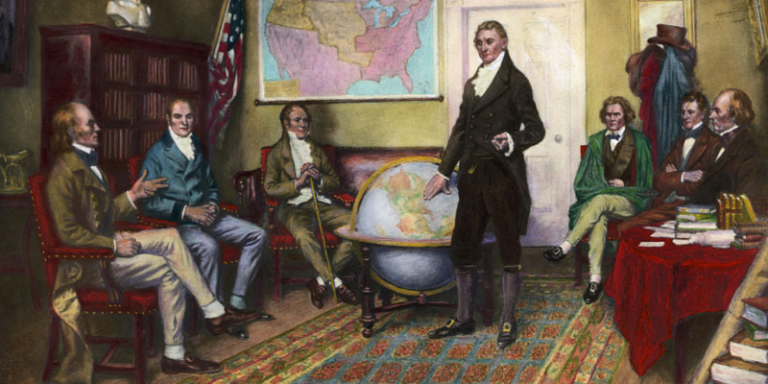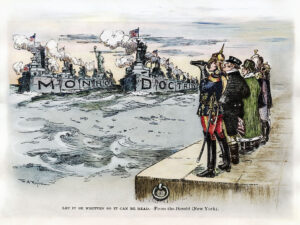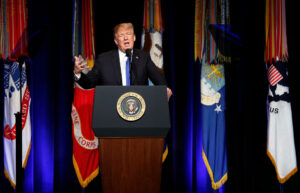The Foreign Policy Doctrines from US History
With the Trump Doctrine coming to an end, what other doctrines were there?
By: Andrew Moran | November 17, 2020 | 719 Words

Painting by Clyde De Land of the birth of the Monroe Doctrine (Getty Images)
While foreign policy did not dominate the 2020 U.S. presidential election, President Donald Trump achieved remarkable success on this file during his term in the Oval Office. Brokering Middle East peace agreements, winding down the number of U.S. troops overseas, and entering diplomatic negotiations with the nation’s adversaries – the Trump administration adopted a new approach to foreign policy, straying away from preceding presidencies. But what has U.S. foreign policy looked like over the years?
The Monroe Doctrine
President James Monroe declared that he would not let European powers further colonize the United States or interfere in the domestic affairs of independent states, referring to them as “puppet monarchs.” In exchange, President Monroe pledged during the seventh State of the Union address that the U.S. would not intervene in the internal workings of European countries.

Political cartoon from the “New York Herald,” showing European rulers observing American naval might. (Getty Images)
The Truman Doctrine
The Second World War forever changed U.S. foreign policy, resulting in a more proactive approach to mitigating potential conflict overseas. In March 1947, President Harry Truman told Congress that the federal government would send money, distribute equipment, and supply military support to nations that were threatened by communism or were resisting communist forces. This was one of the first critical acts in the Cold War.
The Nixon Doctrine
President Richard Nixon took a unique approach to American foreign policy in July 1969. Nixon attempted to strike a fine balance between being a responsible superpower and appeasing U.S. citizens who were apprehensive about providing defense for every nation on the planet. The Nixon Doctrine, also known as the Guam Doctrine, was an objective that stated the U.S. would assist in the defense and developments of allies, but America would not be the perpetual policeman of the world.
The Carter Doctrine
During his final State of the Union address in January 1980, President Jimmy Carter announced that the United States would defend national interests in the Persian Gulf. The Carter Doctrine was in response to the Soviet Union “attempting to consolidate a strategic position, therefore, that poses a grave threat to the free movement of Middle East oil.” As a result, military force would be applied in the region to protect American economic and national interests, primarily supplying a dependent United States with crude oil.
The Reagan Doctrine
Peace through strength. This is how you could summarize President Ronald Reagan’s foreign policy. Many historians and prominent figures have cited the Reagan Doctrine as being a leading factor in the fall of the Soviet Union. The idea behind the philosophy was to offer covert operations to allies fighting communist powers, but without putting boots on the ground.
The Bush Doctrine

Donald Trump (Photo by Martin H. Simon – Pool/Getty Images)
Although President George W. Bush campaigned on a humbler foreign policy, the events of the September 11, 2001 terrorist attacks forever changed America’s presence on the world stage. With the Bush Doctrine, pre-emptive war became the de facto policy of the U.S. government. This concept consists of repelling or defeating a perceived imminent threat, attack, or invasion.
The Trump Doctrine
President Donald Trump’s approach to foreign policy had been a change from the last 20 years, but it also adopted tactics of previous orthodoxies. Ultimately, the Trump Doctrine comprised of placing priority on diplomacy, peace, and economic development with some of America’s adversaries, while still applying pressure on their governments through sanctions. Trump was also the first president in many years to not start a war, showing the effectiveness of his foreign policy doctrine.
The Future of Foreign Policy
What will foreign policy look like under Joe Biden? It is unclear at this point as his campaign was short on details during the 2020 election race. Since Biden, the Democrats, and the mainstream media lamented on President Trump embarking on diplomatic discussions with the likes of Syria’s Bashar al-Assad and North Korea’s Kim Jong-un, logic would dictate that they would reverse some of his accomplishments on the international stage. Will Biden return to the establishment’s status quo foreign policy of endless regime change wars and continue American adventurism abroad? Or will he expand where Trump left off?
















